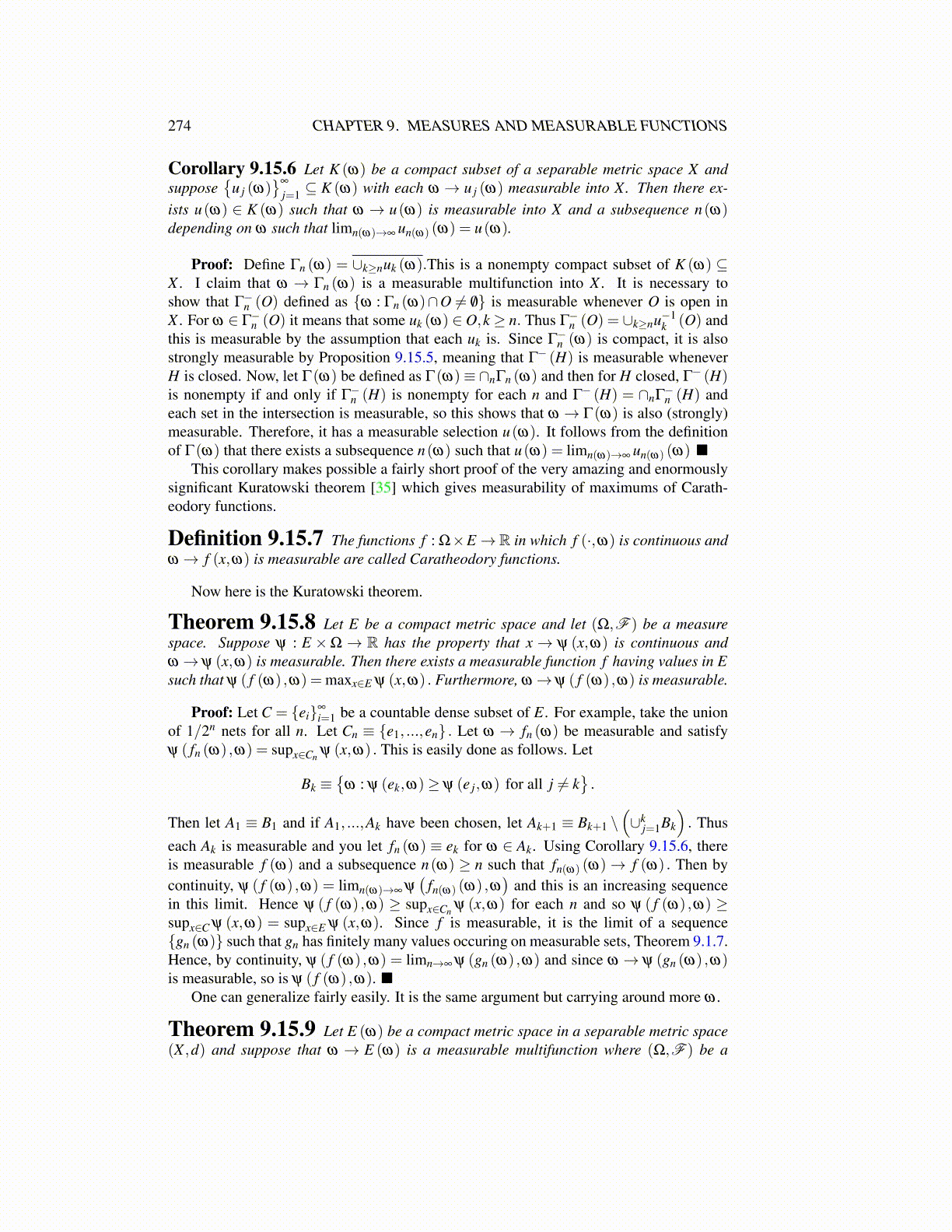
274 CHAPTER 9. MEASURES AND MEASURABLE FUNCTIONS
Corollary 9.15.6 Let K (ω) be a compact subset of a separable metric space X andsuppose
{u j (ω)
}∞
j=1 ⊆ K (ω) with each ω → u j (ω) measurable into X. Then there ex-ists u(ω) ∈ K (ω) such that ω → u(ω) is measurable into X and a subsequence n(ω)depending on ω such that limn(ω)→∞ un(ω) (ω) = u(ω).
Proof: Define Γn (ω) = ∪k≥nuk (ω).This is a nonempty compact subset of K (ω) ⊆X . I claim that ω → Γn (ω) is a measurable multifunction into X . It is necessary toshow that Γ−n (O) defined as {ω : Γn (ω)∩O ̸= /0} is measurable whenever O is open inX . For ω ∈ Γ−n (O) it means that some uk (ω) ∈ O,k ≥ n. Thus Γ−n (O) = ∪k≥nu−1
k (O) andthis is measurable by the assumption that each uk is. Since Γ−n (ω) is compact, it is alsostrongly measurable by Proposition 9.15.5, meaning that Γ− (H) is measurable wheneverH is closed. Now, let Γ(ω) be defined as Γ(ω)≡∩nΓn (ω) and then for H closed, Γ− (H)is nonempty if and only if Γ−n (H) is nonempty for each n and Γ− (H) = ∩nΓ−n (H) andeach set in the intersection is measurable, so this shows that ω → Γ(ω) is also (strongly)measurable. Therefore, it has a measurable selection u(ω). It follows from the definitionof Γ(ω) that there exists a subsequence n(ω) such that u(ω) = limn(ω)→∞ un(ω) (ω) ■
This corollary makes possible a fairly short proof of the very amazing and enormouslysignificant Kuratowski theorem [35] which gives measurability of maximums of Carath-eodory functions.
Definition 9.15.7 The functions f : Ω×E→R in which f (·,ω) is continuous andω → f (x,ω) is measurable are called Caratheodory functions.
Now here is the Kuratowski theorem.
Theorem 9.15.8 Let E be a compact metric space and let (Ω,F ) be a measurespace. Suppose ψ : E ×Ω → R has the property that x → ψ (x,ω) is continuous andω→ ψ (x,ω) is measurable. Then there exists a measurable function f having values in Esuch that ψ ( f (ω) ,ω) = maxx∈E ψ (x,ω) . Furthermore, ω→ψ ( f (ω) ,ω) is measurable.
Proof: Let C = {ei}∞
i=1 be a countable dense subset of E. For example, take the unionof 1/2n nets for all n. Let Cn ≡ {e1, ...,en} . Let ω → fn (ω) be measurable and satisfyψ ( fn (ω) ,ω) = supx∈Cn
ψ (x,ω) . This is easily done as follows. Let
Bk ≡{
ω : ψ (ek,ω)≥ ψ (e j,ω) for all j ̸= k}.
Then let A1 ≡ B1 and if A1, ...,Ak have been chosen, let Ak+1 ≡ Bk+1 \(∪k
j=1Bk
). Thus
each Ak is measurable and you let fn (ω) ≡ ek for ω ∈ Ak. Using Corollary 9.15.6, thereis measurable f (ω) and a subsequence n(ω) ≥ n such that fn(ω) (ω)→ f (ω) . Then bycontinuity, ψ ( f (ω) ,ω) = limn(ω)→∞ ψ
(fn(ω) (ω) ,ω
)and this is an increasing sequence
in this limit. Hence ψ ( f (ω) ,ω) ≥ supx∈Cnψ (x,ω) for each n and so ψ ( f (ω) ,ω) ≥
supx∈C ψ (x,ω) = supx∈E ψ (x,ω). Since f is measurable, it is the limit of a sequence{gn (ω)} such that gn has finitely many values occuring on measurable sets, Theorem 9.1.7.Hence, by continuity, ψ ( f (ω) ,ω) = limn→∞ ψ (gn (ω) ,ω) and since ω → ψ (gn (ω) ,ω)is measurable, so is ψ ( f (ω) ,ω). ■
One can generalize fairly easily. It is the same argument but carrying around more ω .
Theorem 9.15.9 Let E (ω) be a compact metric space in a separable metric space(X ,d) and suppose that ω → E (ω) is a measurable multifunction where (Ω,F ) be a